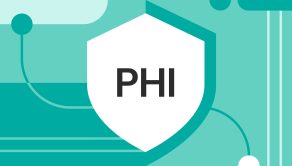Digital footprint explained: definition and real-life examples [2025]

In an age where nearly every action can leave an imprint on the internet, understanding your digital footprint is more crucial than ever. Our online activities, from social media posts to search engine queries, collectively contribute to a trail of data that reflects our presence in the digital world.
A digital footprint not only includes information intentionally shared, known as an active footprint, but also data collected passively through our online behavior. Recognizing the types of footprints can reveal the extent of our online impact and its significance in today’s society.
What is a digital footprint?
A digital footprint refers to the trail of data that individuals create when using the internet. It includes the websites visited, emails sent, and information submitted to online services. There are two main types of digital footprints: active and passive.
An active footprint is created when a user deliberately shares information on social media platforms or when posting online reviews. Passive footprints, on the other hand, are created when a person’s online activity is tracked by websites capturing their IP address, and search history, or when cookies collect data on online shopping behaviors.
It’s important for internet users to be aware of their online presence, as digital footprints can impact online reputation and privacy. Strong passwords, updated privacy settings on social media accounts, and being selective about the personal details shared online can safeguard against identity theft and maintain a positive digital identity.
Potential employers, threat actors, and even social media sites constantly assess digital footprints, potentially affecting job prospects and personal security. Regular monitoring of one’s digital footprint, including reviewing search engine results for your name and inspecting social media profiles, is crucial in the digital age.
Types of digital footprints
A digital footprint is the record of an individual’s interactions and activities on the internet, which can be analyzed to determine their interests, habits, and preferences.
Active digital footprints
An active digital footprint consists of the data that you intentionally submit online. This includes actions such as posting on social media platforms, leaving comments on news articles, signing up for newsletters with your email address, or publishing content on a blog. Each time you fill out an online form, make online purchases, or send an email, you contribute to your active digital footprint.
Key characteristics of active digital footprints include:
- Deliberate sharing of personal information
- Contributions to online discussions or forums
- Content creation for personal or professional profiles
Active digital footprints are often associated with a social media presence and participating in various online communities. By actively engaging with social media sites and other online platforms, you define your digital identity and shape how others perceive you on the internet.
Passive digital footprints
In contrast to the active footprint, a passive digital footprint is created when data is collected about an individual without their direct input. This is often done through tracking technologies such as cookies or by logging IP addresses when you visit websites. Even if you do not actively submit personal details, your online behavior can be cataloged leading to a passive footprint. This type of footprint includes:
- Records of web pages visited (search history)
- Advertisements clicked
- Location data captured during online activity
- Records of online purchases and viewing habits
Passive footprints can provide insights into an individual’s interests, which can be used by marketers to target advertising or by threat actors to identify potential vulnerabilities. It is thus important for every internet user to be aware of their passive digital footprints, as these can affect privacy and security without the user’s active participation.
By understanding the implications of both active and passive digital footprints, individuals can take the necessary steps to protect their online reputation and privacy. These steps might include regularly reviewing privacy settings, monitoring social media accounts, and being vigilant about the information shared on online platforms.
Impact on personal reputation
An individual’s digital footprint has a considerable impact on their personal reputation, as it is largely visible to anyone with internet access, including potential employers, friends, family, and even Threat actors. Social media accounts and the content one posts or interacts with can greatly influence how others view them.
For instance, a social media post that may have been intended as a joke might be misinterpreted and have unintended consequences. Online activity, such as comments made in public forums or photos uploaded to social media profiles, can create lasting impressions that contribute to one’s overall reputation. This digital record can be scrutinized and may speak volumes about a person’s character, beliefs, and behavior.
Impact on employment prospects
Digital footprints play a significant role in employment opportunities. Potential employers routinely search the digital presence of job applicants as part of the hiring process. They may assess an applicant’s professionalism and fit within the company culture based on their online accounts and activity.
Negative elements found via a search engine or on social media sites can be detrimental to a job seeker’s prospects. Conversely, a positive online reputation that showcases professionalism, industry knowledge, and a strong social media presence can be advantageous. Consequently, managing one’s online reputation is of paramount importance for career development.
Impact on online privacy
A digital footprint can have profound implications for online privacy. Social media platforms and other websites track and store vast amounts of data, from search history to online purchases. Even with privacy settings adjusted, passive footprints consisting of IP address logs, cookies, and device information can expose an individual to privacy breaches and identity theft.
Unsecured online accounts, especially those linked to online banking or shopping, can be exploited by cybercriminals, highlighting the importance of strong passwords and secure connections. The continuous expansion of one’s digital footprint can therefore lead to increased vulnerability, making it necessary to be vigilant about the kind of information shared and the measures taken to protect personal data on the internet.
Real-life examples of digital footprints
Digital footprints encapsulate the trace we leave behind when using the internet. Examples of digital footprints are abundant, ranging from a student researching for a term paper, to a shopper finding the best deals online. Each interaction, each click, contributes to the ever-growing digital dossier that represents our virtual selves.
For an internet user visiting various social media sites, the trail may include likes, shares, comments, and social media accounts they’ve created. Job seekers leave their resumes and professional data across networking sites, which is a digital footprint accessible to potential employers. Similarly, a vacationer may unintentionally leave a digital trail by checking into locations on social media platforms, or an enthusiast expressing opinions through online forums and reviews.
Positive Examples
Positive manifestations of digital footprints can often be seen in the professional world. For example, maintaining robust social media profiles on platforms like LinkedIn can help individuals network and locate job opportunities. Professionals also use online platforms to share their portfolio which enhances their online presence and showcases their skills to a broader audience.
| Activity | Positive Impact |
|---|---|
| Online Networking | Expands professional connections, opens job prospects. |
| Blogging | Establishes thought leadership in a field. |
| E-Learning | Reflects a commitment to self-improvement. |
| Online Purchases | Aids in customizing future shopping experiences. |
Educators and learners participate in e-learning platforms, demonstrating a commitment to continuous learning. This can positively reflect on an individual’s drive and dedication to personal growth. Moreover, consumers who make frequent online purchases create a digital footprint that businesses can analyze to provide more personalized shopping experiences in the future.
Negative Examples
However, not all digital footprints have a beneficial impact; some can be detrimental. A glaring example is oversharing personal information on social media platforms, which can lead to privacy invasions or cyberbullying. Additionally, personal data breaches can result from using insecure online banking services or shopping on unverified websites.
| Risk Factor | Negative Consequence |
|---|---|
| Oversharing | Personal information vulnerability and harassment. |
| Insecure Websites | Increased risk of identity theft and fraud. |
| Poor Privacy Habits | Exposes to unwanted online tracking and profiling. |
A careless social media post made in jest might resurface to damage a person’s online reputation, impacting their employment prospects. Certain negative reviews and contentious opinions shared online have led to real-world repercussions, including legal issues. Finally, internet users who neglect to use strong passwords and disregard privacy settings on their various online accounts can fall victim to identity theft and other forms of online exploitation.
These examples underscore the significance of being mindful about our online activity and the digital evidence it leaves. It’s become crucial for internet users to consider the implications of their digital footprints and take active steps to manage them effectively.
Consequences of a digital footprint
Consequences of a digital footprint are multifaceted and can impact an internet user’s online reputation and privacy. A digital footprint, comprising both active and passive elements, represents the information left online as a result of online activity.
Privacy and Security:
- Personal details shared on social media platforms can lead to identity theft.
- Strong passwords reduce the risk of unauthorized access to online accounts.
- Search history and online purchases can be tracked and used for targeted advertising.
Professional Implications:
- Potential employers often review social media profiles, which could affect job opportunities.
- A negative online reputation, stemming from social media posts or online reviews, may harm career prospects.
Social Consequences:
- Information shared on social media accounts, such as photos or opinions, can lead to personal judgment and cyberbullying.
- Privacy settings on social media sites are crucial to control the visibility of one’s social media presence.
Marketing and Personalization:
- Digital footprints allow companies to personalize online shopping experiences.
- IP addresses and search engine data help in delivering more relevant content to the user.
In summary, a digital footprint has significant implications for privacy, security, professional opportunities, and personal social dynamics. It’s essential to manage one’s online presence vigilantly to mitigate potential negative consequences.
How to manage your digital footprint
Managing your digital footprint is essential to maintaining your online reputation, enhancing your privacy, and protecting against identity theft. By taking active steps to oversee the information that’s available about you online, you can better control your digital identity.
Assessing your online presence
The first step in managing your digital presence is to understand its scope. This means conducting a thorough search for your name across different search engines and social media platforms. Don’t neglect to check image searches and online directories. Take note of any social media posts, forum participations, professional profiles, personal blogs, or mentions in news articles. Remember to search for any old or forgotten social media accounts that may contain information about you.
Table Example of Information Assessment:
| Type | Description | Action Needed |
|---|---|---|
| Social Media Posts | Personal photos, status updates | Review Privacy Settings |
| Professional Profiles | LinkedIn, industry forums | Update regularly |
| Online Purchases | Shopping profiles, order history | Secure with strong passwords |
| Search History | Data stored by browsers | Clear regularly |
List Example of Information Sources:
- Social media profiles (Facebook, Twitter, Instagram, etc.)
- Professional networks (LinkedIn)
- Public records and news articles
- Blog posts and online publications
- Online reviews and comments
Strategies for reducing your footprint
Several strategies can help you minimize your digital footprint:
- Delete or deactivate old accounts that you no longer use.
- Set strict privacy settings on your social media sites to limit who can view your information.
- Be cautious about what personal details you share online—consider the potential long-term visibility of this information.
- Regularly review and update your security settings and passwords.
- Avoid using the same password across multiple sites to prevent a breach on one site from affecting others.
- Be judicious in your online activities; think twice before posting or commenting on social media platforms.
Tools for monitoring your digital footprint
Several tools and services can help monitor your digital footprint:
- Google Alerts: Set up alerts for your name or email address to receive notifications when you are mentioned online.
- Identity Theft Protection Services: Services that provide monitoring and alerts if your personal information is used in ways that could suggest identity theft.
- Privacy Checkup Features: Many social media accounts include a privacy checkup tool that assists in reviewing your privacy settings.
- Security Software: High-quality antivirus and anti-malware software often contain features for monitoring and alerting you of privacy concerns.
Best practices for safeguarding your online identity
Online identities can be vulnerable to misuse and theft. Here are best practices for safeguarding your digital identity:
- Strong Passwords: Use complex passwords and different ones for each online account.
- Privacy Settings: Regularly review the privacy settings on social media platforms to control the visibility of your information.
- Secure Connections: Avoid using public Wi-Fi for sensitive transactions like online banking.
- Updated Software: Ensure that your software, including antivirus programs, is always up to date.
| Action | Best Practice |
|---|---|
| Social Media Use | Limit sharing personal details on social media sites |
| Online Shopping | Use secure websites with ‘https’ in the URL |
| Managing Digital Footprints | Clear browsing history and cookies regularly |
| Email Security | Don’t click on unknown links; use two-factor authentication |
- Vigilant Sharing: Think twice before posting on a social media site; every social media post contributes to your online reputation.
- Monitoring Activity: Regularly check your search history and online accounts for unauthorized activity.
- Educate Yourself: Stay informed about the tactics used by threat actors for identity theft.
By implementing these measures, internet users can create a safer online presence and protect themselves against potential digital threats.





Dimitri is a tech entrepreneur and founder of Onerep, the first fully automated data removal service. Top cybersecurity CEO of 2021 by The Software Report.